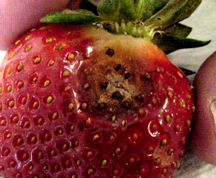
Anthracnose Fruit Rot of Strawberry
Pathogens such as anthracnose, gray mold (Botrytis), and leather rot can become systemic problems in strawberry plantings once established. All three fungal diseases are soil-borne and once in fields can be difficult to manage over the lifetime of the planting.
The use of mulch (matted rows) to prevent/reduce soil splashing and keeping fruit from coming into direct contact with the soil surface can be beneficial in organic production systems where conventional fungicides cannot be used. Use of long crop rotations and staying away from areas of the farm with known instances of any of these pathogens is also important. Remember that same species of Colletotrichum that causes fruit rot in pepper and other crops can also infect strawberry.
Anthracnose Fruit Rot Anthracnose Fruit Rot of Strawberry Control begins with protectant fungicides from flowering through harvest. Begin sprays no later than 10% bloom or prior to disease development and continue on a 7 to 10 day interval. Use the higher rate and shorter intervals when disease pressure is high. Do not make more than two consecutive applications of fungicides other than Captan or Thiram before switching to a fungicide in a different chemical class. Maintain continuous coverage of Captan and/or a FRAC Group 11 fungicide, by applying the following combinations: Application #1: Application #2, apply one of the following: Application #3: For subsequent applications, rotate among the following fungicides or fungicide combinations: When wet weather persists or during bloom, include Elevate or Switch to improve Botrytis control. |
Leather RotLeather rot caused by Phytophthora cactorum can cause losses during warm, wet weather with extended periods of rainfall. Infection can take place during all stages of fruit development as long as favorable conditions are present. Infected fruit turn brown and have blotchy tough appearance. Infections typically occur in fruit that are in direct contact with the soil, but the pathogen can also be splashed onto fruit via rainfall and wind.Research by Dr. Mike Ellis, Using Fungicides to Control Strawberry Fruit Rots in Ohio, has shown that FRAC code 11 fungicides such as Cabrio, Abound, and Pristine are effective against leather rot. Pristine being the fungicide of choice because it also provides control of gray mold and anthracnose. Follow the link above for an excellent review of all three of these diseases and a useful efficacy table. Additionally, foliar applications of a phosphite-based product on 7 day intervals can be done as long as favorable disease conditions occur. These products include: Fungicides containing mefenoxam or metalaxyl can be applied as sprays or through drip irrigation. These fungicides include: |
Gray Mold (Botrytis Fruit Rot) Gray Mold (Botrytis Fruit Rot) Control of gray mold, like the other diseases, begins with recognizing the conditions for its development, its symptoms, and preventative fungicide applications. Start sprays when plants begin to bloom, because 90% of fruit infections occur through the flower, and repeat every 7-10 days. Increase spray intervals during persistent dry periods, but decrease intervals to 5-7 days during very wet periods. Four weekly sprays starting at 5-10% bloom are usually sufficient for season-long control. Tank-mix and rotate fungicides from different FRAC codes to reduce the chances for fungicide resistance development. Application #1, apply one of the following: Application #2, apply one of the following: If frequent prior use of the above materials indicates a potential risk for resistance development. Application #3: same as Application #1 For subsequent applications, rotate between two or more of the following fungicides: |
For more information on the control of anthracnose fruit rot, gray mold, and leather rot please see the 2014 Commercial Vegetable Production Recommendations Guide.


